Optical fiber cable is an important part of the optical fiber network. It is the connecting cable for GPon EPon ONU fiber modem and OLT. The transmission distance of the optical fiber cable depends on many factors, including the type of optical fiber, the wavelength of the light used, and the signal amplification and regeneration used. Equipment type.
Types of Fiber and Typical Distances
Single-Mode Fiber (SMF):
- Standard SMF: Typically used for long-distance communication, it can transmit data over distances of 40 to 100 kilometers (km) without the need for signal regeneration. With advanced amplification and signal processing techniques, distances can extend to several hundred kilometers.
- Ultra-Low-Loss SMF: This type can achieve even longer distances, often exceeding 1000 km with proper amplification and dispersion management.
Learn More about SMF: Single-mode optical fiber

Multi-Mode Fiber (MMF):
- OM1 and OM2 Fibers: Generally used for shorter distances, up to 300 meters (m) for OM1 and 550 m for OM2 at 1 Gbps.
- OM3 and OM4 Fibers: Enhanced versions of multi-mode fibers can support distances of up to 300 m (OM3) and 400 m (OM4) at 10 Gbps, and up to 100 m at 40 Gbps or 100 Gbps.
Optical fiber Factors Affecting Transmission Distance
Wavelength:
- 850 nm (Multi-Mode): Commonly used in MMF for shorter distances.
- 1310 nm and 1550 nm (Single-Mode): Used in SMF for longer distances due to lower attenuation and better dispersion properties.


Amplification and Regeneration:
- Optical Amplifiers: Such as Erbium-Doped Fiber Amplifiers (EDFAs), extend transmission distances by amplifying the light signal without converting it to an electrical signal.
- Regenerators: Convert the optical signal to an electrical signal, clean it up, and then retransmit it as an optical signal. This process can greatly extend the overall transmission distance.
Dispersion Management:
- Techniques to manage chromatic dispersion (different wavelengths of light spreading out over distance) and polarization mode dispersion (variation in the speed of light through the fiber) are crucial for maintaining signal integrity over long distances.
Optical fiber Real-World Applications
- Transoceanic Cables: Undersea fiber optic cables connecting continents can span thousands of kilometers, using a combination of ultra-low-loss fibers, EDFAs, and advanced signal processing techniques.
- Terrestrial Long-Haul Networks: These typically span hundreds of kilometers between cities, employing similar technologies to those used in undersea cables but optimized for terrestrial environments.
In summary, single-mode fibers are suitable for distances ranging from tens to hundreds of kilometers, potentially reaching thousands of kilometers with advanced technologies, while multi-mode fibers are ideal for shorter distances up to a few hundred meters. The specific application and required transmission distance will determine the choice of fiber type and the necessary technologies for amplification and dispersion management.





